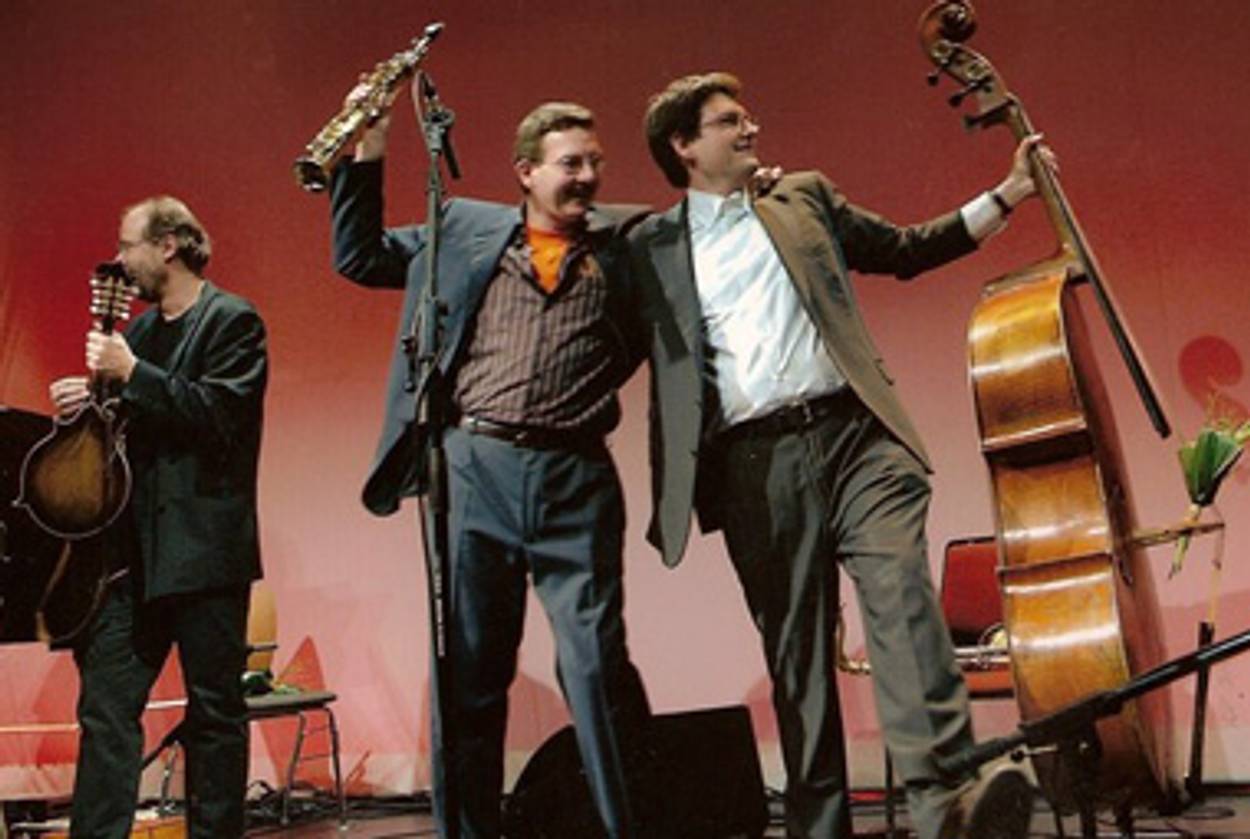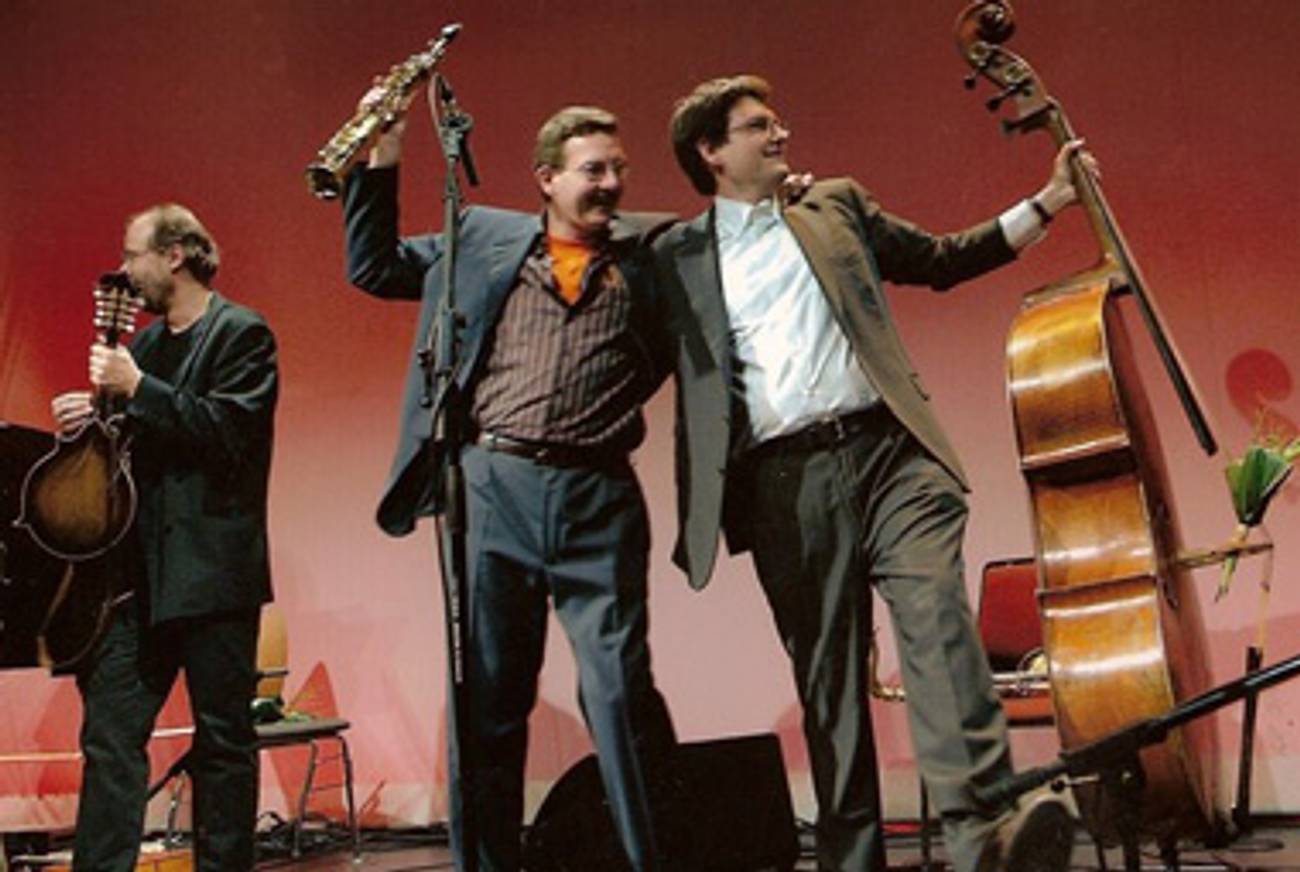Inheritance
A pair of Swiss musicians brought their Jewishness back from the dead




When Cioma Schönhaus fled to Switzerland from Berlin on his bicycle in 1943—a story he tells in The Forger, a memoir of the four years he spent living by his wits as a Jew in the heart of wartime Germany—there wasn’t much that he could take with him. Not much that he could touch, at least. “The songs from his family were the only belongings he was able to carry with him over the border,” his son David said in an email to me. (The email is in German, which I don’t speak. My wife, Ingrid, who attended the Swiss equivalent of junior high school with David in Basel, translated for me.) “He sang many of these songs over and over again. When he was driving the car, or walking the dog, he was always singing.”
Those songs were the only Jewish thing that Cioma chose to bequeath to David and his younger son, Sascha. Like many survivors who lost their families during the war, Cioma’s feelings about Judaism were complicated. “He’s very critical of Jewry and consciously chose not to raise us as Jews, but a Jewish consciousness was always present,” said David. “He was absolutely convinced that being Jewish is what killed his parents. We grew up in a Christian milieu; our Jewishness was limited to stories and history.”
Stories and history, and those songs. Years later, when David, a bassist, and Sascha, a saxophonist, decided to pursue careers in music, they began to re-examine the music of their childhood. Before long, they had teamed up with the German violinist Andreas Wäldele to form a klezmer ensemble, Baith Jaffe; the name is a German transliteration of the Hebrew form of Schönhaus, or “pretty house.”
The quartet, which also includes pianist Niculin Christen, performs many of the tunes that Cioma brought with him from Berlin: classics like “Oifn Pripetshok“ and “Oifn Weg,” which became the title tracks of the band’s first two recordings; lesser known pieces like “Main Tairer Mann” (“My Dear Man”), which tells the story of a woman whose husband emigrates, never to be heard from again; and near-oddities like “Wie Ist Dos Gessele” (“Where Is the Street”), which Cioma sang in Russian—his own father had served in the Red Army, contributing more than a few songs (some of them X-rated) to the family repertoire—but which had been recorded in Yiddish during the 1920s.
The brothers dove into the same archival recordings that have served as touchstones for American klezmer revivalists, including discs by David Tarras, Naftule Brandwein, and Abe Schwarz. They listened to Andy Statman, the mandolin player and clarinetist whose work traverses bluegrass, Hasidic niggun, and late John Coltrane; they performed alongside the Epstein Brothers, one of the last surviving klezmer bands from the 1940s; and they collaborated with the late Marcel Lang, a Swiss cantor who taught them about Jewish music and religion before his death in June. “The band served as our entry point to Judaism,” David said.
Ultimately, David and Sascha arrived at their own version of Jewish roots music, one that draws on traditional Ashkenazi materials but also alludes to classical music, Russian folk music, and jazz—a mixture of personal and contemporary elements which comprises their family’s musical legacy. (They tend to tailor their approach to their repertoire, which means you can hear them get all Russian on “Katjusha”, or sort of jazzy and Americana-ish on “Andy Statman 17″, or unapologetically Jewy on the Epstein Brothers’ “Chassidic Medley.”)
Their approach appears to have struck a chord. David estimates that 80 percent of their European audiences are non-Jewish and says they always play to sold-out houses. They do the bar mitzvah and Jewish wedding circuit, play festivals in Switzerland, Germany, France, and England, and even venture to the United States, where they recently gave a series of concerts at Pacific Lutheran University.
And Cioma? “He has a very ambivalent view of our band,” David said. “On the one hand, he loves our music. On the other, he believes in creating a world religion in which Judaism no longer has a place. But he’s always supported us in our work, and is proud of our success.”
***
While David and Sascha have spent the last 20-odd years coming to terms musically with their family history, Kat Parra only recently discovered hers. Parra studied voice in college with Patti Cathcart, of Tuck & Patti. But life, in the guise of an early marriage, two children, and a divorce, interrupted her dreams of a musical career. She spent eight years waiting tables and another six working as a graphic designer for Cisco Systems while singing jazz, R&B, and salsa on the side.
Then three things happened: her youngest son graduated college, enabling her to quit her corporate gig and pursue music full-time; she discovered through a family-tree project that despite her Ashkenazi upbringing, her maternal grandfather had been a Sephardic Jew from the Iberian Peninsula; and she encountered Sephardic music on a trip to Spain. The result: a series of albums that have explored, in ever greater depth, “Sephardic world jazz”—an artful mishmash of traditional Sephardic songs and different forms of Latin music.
Parra’s latest release, Dos Amantes, includes a buoyant Latin jazz rendition of the old drinking song, “La Vida Do Por El Raki” (“I Would Give My Life for Raki”) and a sumptuously orchestrated version of “Fiestaremos” (“Let Us Celebrate”) set to the African-derived rhythms of a Peruvian lando. The disc benefits greatly from the work of several highly skilled arrangers, including Bay Area veterans Wayne Wallace and Murray Low, and from a gimcrack band that combines the delicate flute-and-violin instrumentation of a Cuban charanga ensemble with steely rhythmic precision.
Maybe Parra’s Sephardic grandfather would regard this reimagining of his cultural legacy with the same ambivalence as Cioma Schönhaus. Or maybe he’d just slip on his dancing shoes, toss back some raki, and join the party.
Alexander Gelfand is a recovering ethnomusicologist, a sometime jazz pianist, and a former West African drummer. His work has appeared in the New York Times, the Chicago Tribune, the Forward, and elsewhere.
Alexander Gelfand is a recovering ethnomusicologist, a sometime jazz pianist, and a former West African drummer. His work has appeared in the New York Times, the Chicago Tribune, the Forward, and elsewhere.